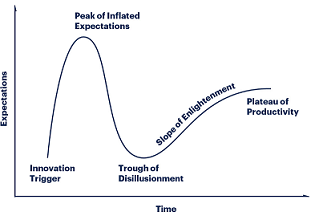[Editor’s Note: Mad Scientist Laboratory is pleased to present our August edition of “The Queue” – a monthly post listing the most compelling articles, books, podcasts, videos, and/or movies that the U.S. Army’s Training and Doctrine Command (TRADOC) Mad Scientist Initiative has come across during the past month. In this anthology, we address how each of these works either informs or challenges our understanding of the Future Operational Environment. We hope that you will add “The Queue” to your essential reading, listening, or watching each month!]

1. “5 Trends Emerge in the Gartner Hype Cycle for Emerging Technologies,” by Kasey Panetta, Gartner, 16 August 2018.
Gartner’s annual hype cycle highlights many of the technologies and trends explored by the Mad Scientist program over the last two years. This year’s cycle added 17 new technologies and organized them into five emerging trends: 1) Democratized Artificial Intelligence (AI), 2) Digitalized Eco-Systems, 3) Do-It-Yourself Bio-Hacking, 4) Transparently Immersive Experiences, and 5) Ubiquitous Infrastructure. Of note, many of these technologies have a 5–10 year horizon until the Plateau of Productivity. If this time horizon is accurate, we believe these emerging technologies and five trends will have a significant role in defining the Character of Future War in 2035 and should have modernization implications for the Army of 2028. For additional information on the disruptive technologies identified between now and 2035, see the Era of Accelerated Human Progress portion of our Potential Game Changers broadsheet.
[Gartner disclaimer: Gartner does not endorse any vendor, product or service depicted in its research publications, and does not advise technology users to select only those vendors with the highest ratings or other designation. Gartner research publications consist of the opinions of Gartner’s research organization and should not be construed as statements of fact. Gartner disclaims all warranties, expressed or implied, with respect to this research, including any warranties of merchantability or fitness for a particular purpose.]

2. “Should Evil AI Research Be Published? Five Experts Weigh In,” by Dan Robitzski, Futurism, 27 August 2018.
The following rhetorical (for now) question was posed to the “AI Race and Societal Impacts” panel during last month’s The Joint Multi-Conference on Human-Level Artificial Intelligence in Prague, The Czech Republic:
“Let’s say you’re an AI scientist, and you’ve found the holy grail of your field — you figured out how to build an artificial general intelligence (AGI). That’s a truly intelligent computer that could pass as human in terms of cognitive ability or emotional intelligence. AGI would be creative and find links between disparate ideas — things no computer can do today.
That’s great, right? Except for one big catch: your AGI system is evil or could only be used for malicious purposes.
So, now a conundrum. Do you publish your white paper and tell the world exactly how to create this unrelenting force of evil? Do you file a patent so that no one else (except for you) could bring such an algorithm into existence? Or do you sit on your research, protecting the world from your creation but also passing up on the astronomical paycheck that would surely arrive in the wake of such a discovery?”
The panel’s responses ranged from controlling — “Don’t publish it!” and treat it like a grenade, “one would not hand it to a small child, but maybe a trained soldier could be trusted with it”; to the altruistic — “publish [it]… immediately” and “there is no evil technology, but there are people who would misuse it. If that AGI algorithm was shared with the world, people might be able to find ways to use it for good”; to the entrepreneurial – “sell the evil AGI to [me]. That way, they wouldn’t have to hold onto the ethical burden of such a powerful and scary AI — instead, you could just pass it to [me and I will] take it from there.”
While no consensus of opinion was arrived at, the panel discussion served a useful exercise in illustrating how AI differs from previous eras’ game changing technologies. Unlike Nuclear, Biological, and Chemical weapons, no internationally agreed to and implemented control protocols can be applied to AI, as there are no analogous gas centrifuges, fissile materials, or triggering mechanisms; no restricted access pathogens; no proscribed precursor chemicals to control. Rather, when AGI is ultimately achieved, it is likely to be composed of nothing more than diffuse code; a digital will’o wisp that can permeate across the global net to other nations, non-state actors, and super-empowered individuals, with the potential to facilitate unprecedentedly disruptive Information Operation (IO) campaigns and Virtual Warfare, revolutionizing human affairs. The West would be best served in emulating the PRC with its Military-Civil Fusion Centers and integrate the resources of the State with the innovation of industry to achieve their own AGI solutions soonest. The decisive edge will “accrue to the side with more autonomous decision-action concurrency on the Hyperactive Battlefield” — the best defense against a nefarious AGI is a friendly AGI!

3. “Can Justice be blind when it comes to machine learning? Researchers present findings at ICML 2018,” The Alan Turing Institute, 11 July 2018.
Can justice really be blind? The International Conference on Machine Learning (ICML) was held in Stockholm, Sweden, in July 2018. This conference explored the notion of machine learning fairness and proposed new methods to help regulators provide better oversight and practitioners to develop fair and privacy-preserving data analyses. Like ethical discussions taking place within the DoD, there are rising legal concerns that commercial machine learning systems (e.g., those associated with car insurance pricing) might illegally or unfairly discriminate against certain subgroups of the population. Machine learning will play an important role in assisting battlefield decisions (e.g., the targeting cycle and commander’s decisions) – especially lethal decisions. There is a common misperception that machines will make unbiased and fair decisions, divorced from human bias. Yet the issue of machine learning bias is significant because humans, with their host of cognitive biases, code the very programming that will enable machines to learn and make decisions. Making the best, unbiased decisions will become critical in AI-assisted warfighting. We must ensure that machine-based learning outputs are verified and understood to preclude the inadvertent introduction of human biases. Read the full report here.

4. “Uptight robots that suddenly beg to stay alive are less likely to be switched off by humans,” by Katyanna Quach, The Register, 3 August 2018.
In a study published by PLOS ONE, researchers found that a robot’s personality affected a human’s decision-making. In the study, participants were asked to dialogue with a robot that was either sociable (chatty) or functional (focused). At the end of the study, the researchers let the participants know that they could switch the robot off if they wanted to. At that moment, the robot would make an impassioned plea to the participant to resist shutting them down. The participants’ actions were then recorded. Unexpectedly, there were a large number of participants who resisted shutting down the functional robots after they made their plea, as opposed to the sociable ones. This is significant. It shows, beyond the unexpected result, that decision-making is affected by robotic personality. Humans will form an emotional connection to artificial entities despite knowing they are robotic if they mimic and emulate human behavior. If the Army believes its Soldiers will be accompanied and augmented heavily by robots in the near future, it must also understand that human-robot interaction will not be the same as human-computer interaction. The U.S. Army must explore how attain the appropriate level of trust between Soldiers and their robotic teammates on the future battlefield. Robots must be treated more like partners than tools, with trust, cooperation, and even empathy displayed.

5. “Spending on Internet of Things May More Than Double to Over Half a Trillion Dollars,” by Aaron Pressman, Fortune, 8 August 2018.
While the advent of the Internet brought home computing and communication even deeper into global households, the revolution of smart phones brought about the concept of constant personal interconnectivity. Today and into the future, not only are humans being connected to the global commons via their smart devices, but a multitude of devices, vehicles, and various accessories are being integrated into the Internet of Things (IoT). Previously, the IoT was addressed as a game changing technology. The IoT is composed of trillions of internet-linked items, creating opportunities and vulnerabilities. There has been explosive growth in low Size Weight and Power (SWaP) and connected devices (Internet of Battlefield Things), especially for sensor applications (situational awareness).
Large companies are expected to quickly grow their spending on Internet-connected devices (i.e., appliances, home devices [such as Google Home, Alexa, etc.], various sensors) to approximately $520 billion. This is a massive investment into what will likely become the Internet of Everything (IoE). While growth is focused on known devices, it is likely that it will expand to embedded and wearable sensors – think clothing, accessories, and even sensors and communication devices embedded within the human body. This has two major implications for the Future Operational Environment (FOE):
– The U.S. military is already struggling with the balance between collecting, organizing, and using critical data, allowing service members to use personal devices, and maintaining operations and network security and integrity (see banning of personal fitness trackers recently). A segment of the IoT sensors and devices may be necessary or critical to the function and operation of many U.S. Armed Forces platforms and weapons systems, inciting some critical questions about supply chain security, system vulnerabilities, and reliance on micro sensors and microelectronics
– The U.S. Army of the future will likely have to operate in and around dense urban environments, where IoT devices and sensors will be abundant, degrading blue force’s ability to sense the battlefield and “see” the enemy, thereby creating a veritable needle in a stack of needles.
 6. “Battlefield Internet: A Plan for Securing Cyberspace,” by Michèle Flournoy and Michael Sulmeyer, Foreign Affairs, September/October 2018. Review submitted by Ms. Marie Murphy.
6. “Battlefield Internet: A Plan for Securing Cyberspace,” by Michèle Flournoy and Michael Sulmeyer, Foreign Affairs, September/October 2018. Review submitted by Ms. Marie Murphy.
With the possibility of a “cyber Pearl Harbor” becoming increasingly imminent, intelligence officials warn of the rising danger of cyber attacks. Effects of these attacks have already been felt around the world. They have the power to break the trust people have in institutions, companies, and governments as they act in the undefined gray zone between peace and all-out war. The military implications are quite clear: cyber attacks can cripple the military’s ability to function from a command and control aspect to intelligence communications and materiel and personnel networks. Besides the military and government, private companies’ use of the internet must be accounted for when discussing cyber security. Some companies have felt the effects of cyber attacks, while others are reluctant to invest in cyber protection measures. In this way, civilians become affected by acts of cyber warfare, and attacks on a country may not be directed at the opposing military, but the civilian population of a state, as in the case of power and utility outages seen in eastern Europe. Any actor with access to the internet can inflict damage, and anyone connected to the internet is vulnerable to attack, so public-private cooperation is necessary to most effectively combat cyber threats.
If you read, watch, or listen to something this month that you think has the potential to inform or challenge our understanding of the Future Operational Environment, please forward it (along with a brief description of why its potential ramifications are noteworthy to the greater Mad Scientist Community of Action) to our attention at: usarmy.jble.tradoc.mbx.army-mad-scientist@mail.mil — we may select it for inclusion in our next edition of “The Queue”!



